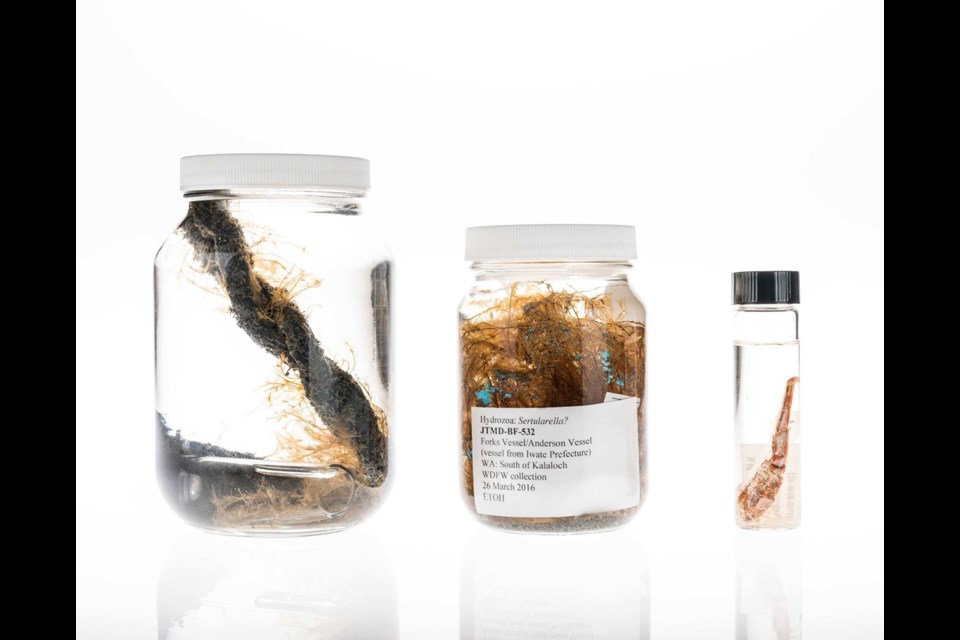This is one of a series of columns by specialists at the Royal sa���ʴ�ý Museum that explore the human and natural worlds of the province.
The 2011 Tohoku earthquake and resulting tsunami washed about 20 million tonnes of debris into the Pacific Ocean and created “rafts” that crossed thousands of kilometres of ocean, unprecedented in the scale and nature of the objects comprising the debris.
For the first time, scientists were able to observe directly the rafting of diverse living communities of coastal organisms from one continent to another. This is the longest documented transoceanic survival and dispersal of coastal species by rafting. Invertebrates including mollusks, crustaceans and annelids (worms) are a significant part of the debris fauna.
Since 2012, Japanese debris from this event has landed on coastlines from Midway to Hawaii, and from south-central Alaska down the sa���ʴ�ý coast to central California. Remarkably, nearly six years later, debris continues to arrive on the west coast of North America, bringing with it more non-native, novel, shallow-water species. As much of the debris comprised non-biodegradable anthropogenic (human-made) materials, objects can persist on the ocean for longer periods than natural rafts.
As I write these words, I am looking at a jar on my desk containing a piece of oyster-farm line, home to a colony of invertebrates called hydroids, cut from a much larger mass that had washed away in the tsunami and that had drifted across the Pacific, arriving in Hawaii in December of 2016. I study hydroids, which are gelatinous, often colonial, animals related to corals and jellyfish.
I was one of several taxonomists (biologists involved in the study of classification and relationships of organisms) asked to examine the Japanese tsunami marine debris hitchhikers in 2012. The project is the first large-scale, long-term study of how marine species are dispersed; it is significant not only because of the scale of transport (large amount of debris between continents) but also because movement of debris was directly observed.
About 289 invertebrate and fish species not previously reported from transoceanic rafting have been documented from the debris. The arrival of these species led to important questions about the state of existing biodiversity on the west coast of North America (including sa���ʴ�ý).
Which species came from Japan? Which species belong to sa���ʴ�ý? For many invertebrates, it was not a simple task to answer these questions. Before we can effectively address the ecological implications of the transport of marine organisms on the Japanese tsunami debris, we need to know which species are arriving on the debris. The debris project reminded us that in order to understand sa���ʴ�ý biodiversity, we have to study both sa���ʴ�ý and non-sa���ʴ�ý fauna. sa���ʴ�ý marine biodiversity is part of Pacific biodiversity.
The arrival of species on the tsunami debris and its biological implications also underscore the importance of museum natural-history collections. A common view of museums is as places of exhibits, where collections arrive, are unpacked, catalogued and put on shelves.
However, there is a lot more to museum collections than objects to be stored away. Comparative collections not only help us to identify species, but also to understand where, how and when they occur. Natural-history collections are records of the history of life on earth, so museums are often the only places that this can be done, and the only places that have the expertise of taxonomists to do so.
In this way, collections-centred biodiversity research in museums such as the Royal sa���ʴ�ý Museum is unique; museum collections and taxonomists remain crucial to the study of biodiversity.
In December 2016, I received a grant from the North Pacific Marine Science Organization, which includes sa���ʴ�ý, Japan, China and South Korea, as well as the U.S., to bring the base collection of organisms recovered from the Japanese tsunami marine debris to the Royal sa���ʴ�ý Museum as an archive for future species verification and research, and to take advantage of future analytical techniques not currently available. The Royal sa���ʴ�ý Museum will
become the repository for the 2011 Japanese tsunami debris base-biological collection.
Having the Japan debris collection at the Royal sa���ʴ�ý Museum is scientifically significant, as human-mediated transoceanic transport of species has the potential to affect many types of coastal habitats and communities. Natural rafting and transport of non-native species by ships and other vessels are not uncommon, but the tsunami marine debris land on a wider variety of coastal habitats, beyond docks and harbours.
The debris project has shown that anthropogenic materials differ from natural, largely ephemeral rafting materials in that they persist indefinitely and allow species to overcome vast expanses of ocean and be dispersed on essentially permanent rafts. Continuing curation and study of the debris material are important, as it is not always possible to detect invasions by alien species immediately, and such detection might not occur for years or decades.
Collaborative research on the Japanese tsunami material has resulted in numerous peer-reviewed scientific publications, including an upcoming special issue of the journal Aquatic Invasions that presents detailed treatments of the taxonomy and systematics of many of the Japan-debris invertebrate and fish groups.
Henry Choong, PhD, is the curator of invertebrate zoology at Royal sa���ʴ�ý Museum. He has published on hydrozoan taxonomy, biogeography, dispersal mechanisms and invasive species. Hydrozoans are mostly marine animals related to jellyfish and corals; their polyp forms are called hydroids.



